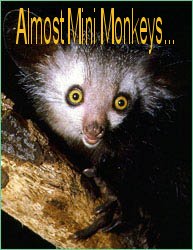Marmosets as well hang-out in the northern Amazon of the Amazon. The Common Marmoset can be found within the tropical rainforest of Brazil, while the Pygmy Marmosets decidedly pick the northern Amazon to crash.
Common Marmosets are distributed throughout the Atlantic Coastal Forest of northeastern Brazil. They must have enough trees to produce exudates (saps and gums) for their food, and sufficient hiding places to escape from predators. The Pygmy Marmosets most often live in trees at the edges of flooded forests, usually along a river. As stated, they are native to the upper Amazon.
Like the monkeys above, Goeldi's Monkeys make their residence in the upper Amazon. Found in countries such as Brazil, Columbia, Eastern Peru, North Bolivia, and Ecuador, they prefer to live on the ground and understory of the forest (although they feed at the top of the trees.) Their habitat is being destroyed by slash and burn agriculture. Endangered to see how you can help)
Squirrel Monkeys can be found in South and Central America. They dwell in tropical rainforests and other forest types, mangrove swamps, and thickets.
Aye-ayes, an "Almost Mini Monkey", reside in the primary and secondary rainforests of South America. They can also be found in the deciduous, secondary growth, and dry scrub forests. This species also occurs in cultivated areas, like coconut groves.
Lemurs are an "Almost Mini Monkey" that, unlike the other primates mentioned, bide only in Madagascar and small islands nearby.
Dwarf Lemurs (again, unlike most other monkeys above) prefer only dry deciduous forests to inhabit. Lesser mouse lemurs enjoy the same environment. They are active mostly in the treetops, where they travel along the branches on all four legs.


|
Go To... Top Habitat Size Endangered
|


|